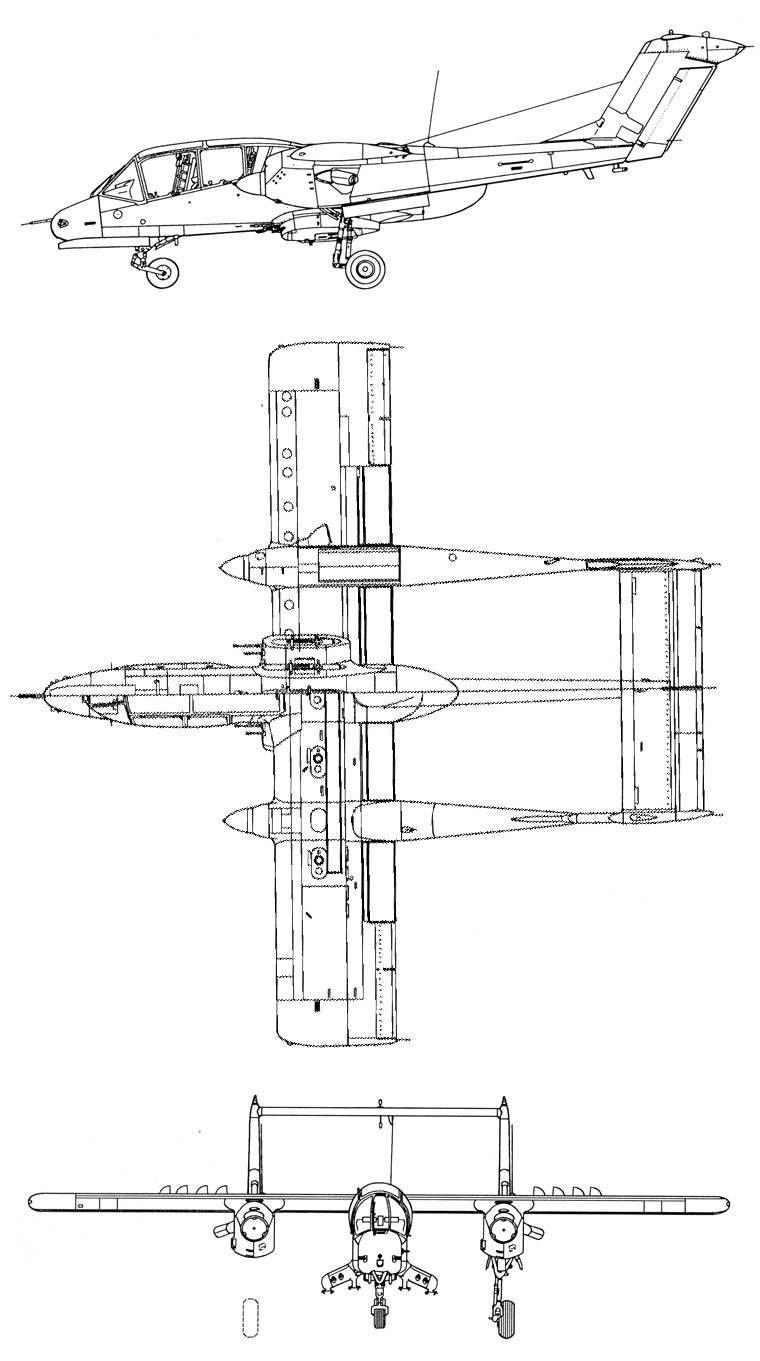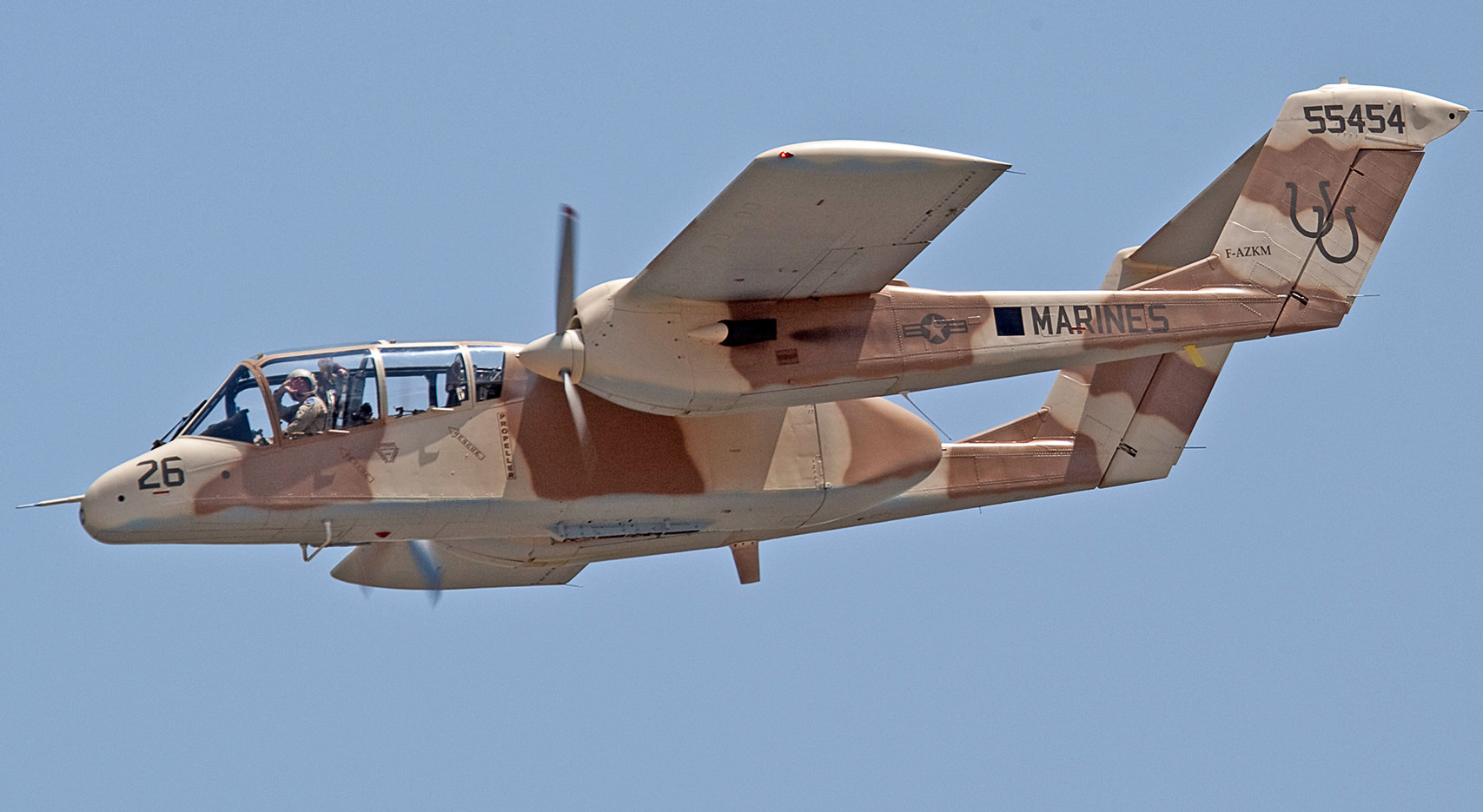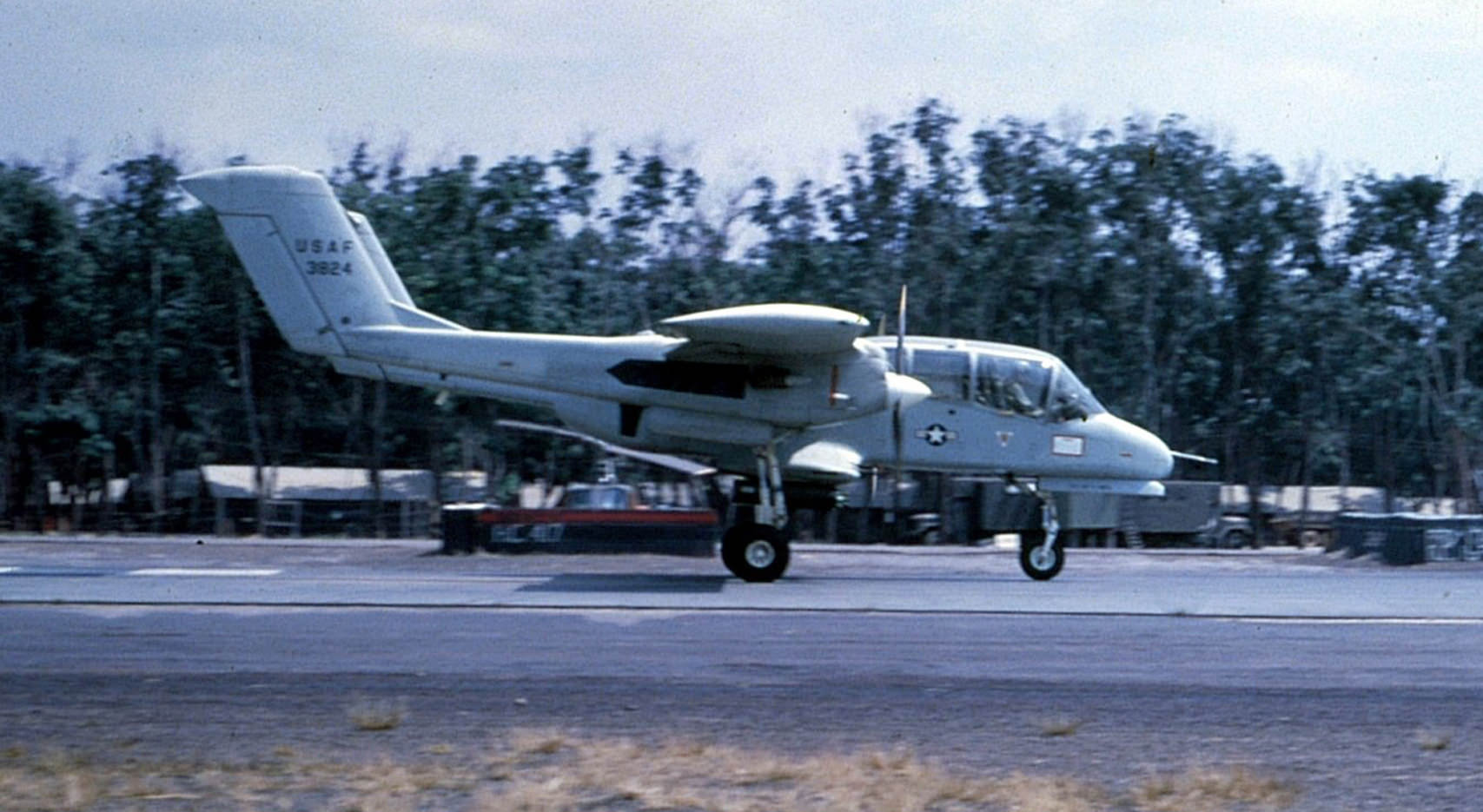Price: $29.95
- 2 magazines, 12 documents, & photos
- PDF contains 3,004 pages
- Content is keyword searchable
- Print a personal copy
- Pay via PayPal or Credit Card
- International orders welcome!
- Download files upon payment
January 1983
- Marine Aviation – Future of Close Support
- Skyhawks, Phantoms, Intruders, Prowlers, Helicopter Gunships, and Harriers
June 2002
- Landcaster: Best Bomber of WWII?
- Saga of the Bell X-2
- Vietnam Combat Artist’s Diary
Manuals & Photos
- OV-10A Flight Manual
- OV-10A NATOPS Flight Manual
- OV-10A Power Package Buildup
- OV-10A Illustrated Parts Breakdown
- OV-10A Airframe Systems
- OV-10D NATOPS Flight Manual
- OV-10D Pocket Checklist
- OV-10 Ejection Seat Maintenance
- OV-10 Operational Training Course
- OV-10 USAF Operations Training Course
- OV-10A (Black Pony) Information Sheet
- OV-10A Bronco Service News
- Over 220 OV-10 Bronco photos
North American Rockwell OV-10 Bronco
OV-10A Specs
OV-10D Specs
Variants
On Display
Cutaway
Videos
General Characteristics

- Crew: two
- Length: 41 ft 7 in (12.67 m)
- Wingspan: 40 ft 0 in (12.19 m)
- Height: 15 ft 2 in (4.62 m)
- Wing area: 290.95 ft² (27.03 m²)
- Empty weight: 6,893 lb (3,127 kg)
- Max. takeoff weight: 14,444 lb (6,552 kg)
- Powerplant: 2 × Garrett T76-G-10/12 turboprop, 715 hp (533 kW) each
Performance
- Maximum speed: 281 mph (452 km/h)
- Range: 576 mi (927 km)
- Service ceiling: 24,000 ft (7,315 m)
Armament
- Guns: 4 × 7.62×51mm M60C machine guns
- Hardpoints: 5 fuselage and 2 underwing and provisions to carry combinations of:
- Rockets: 7- or 19-tube launchers for 2.75″ FFARs or 2- or 4-tube launchers for 5″ FFARs
- Missiles: AIM-9 Sidewinder (Wing pylons only)
- Bombs: up to 500 lb
- Other: SUU-11/A or Mk 4 Mod 0 gun pods
General Characteristics
- Crew: two
- Length: 44 ft 0 in (13.41 m)
- Wingspan: 40 ft 0 in (12.19 m)
- Height: 15 ft 2 in (4.62 m)
- Wing area: 290.95 ft² (27.03 m²)
- Empty weight: 6,893 lb (3,127 kg)
- Loaded weight: 9,908 lb (4,494 kg)
- Max. takeoff weight: 14,444 lb (6,552 kg)
- Tailplane Span 14 ft, 7 in (4.45 m)
- Powerplant: 2 × Garrett T76-G-420/421 turboprop, 1,040 hp (775.5 kW) each
Performance
- Maximum speed: 288 mph (463 km/h)
- Range: 1,382 mi (2,224 km)
- Service ceiling: 30,000 ft (9,159 m)
Armament
- Guns: 1 × 20 mm (0.79 in) M197 cannon (YOV-10D) or 4 × 7.62×51 mm M60C machine guns (OV-10D/D+)
- Hardpoints: 5 fuselage and 2 underwing and provisions to carry combinations of:
- Rockets: 7- or 19-tube launchers for 2.75 in FFARs/2.75 in WAFARs or 2- or 4-tube launchers for 5 in FFARs or WAFARs
- Missiles: AIM-9 Sidewinder on wings only
- Bombs: up to 500 lb (227 kg)
- YOV-10A
- Seven prototype NA-300s with two 600 shp T76-G-6/8 engines, last one was flown with YT74-P-1 engines.
- OV-10A
- Original production version with enlarged wing and 715 shp T76-G-10/12 engines. Distinguished by a long-wire HF antenna between the center rear stabilizer and the central nacelle, 114 for the United States Marine Corps and 157 for the United States Air Force.
- OV-10B
- Target towing variant for Germany, with a target towing pod mounted beneath the fuselage. A clear dome replaced the rear cargo door. The rear seat was moved to the cargo bay to look backwards out the dome, 18 built; known as the OV-10B(Z) when fitted with an additional J85-GE-4 turbojet.
- OV-10B(Z)
- A variation of the German target tug, with one J85-GE-4 turbojet mounted in a nacelle above the fuselage. A total of 18 aircraft were supplied to the Germans.
- OV-10C
- Export version for Thailand; based on the OV-10A, 32 built.
- YOV-10D (NOGS)
- The prototype Night Observation Gunship System variant developed as the YOV-10D, two OV-10A conversions, 155395,155396.
- OV-10D
- Second generation Bronco developed under the NOGS program. The D-model was an extensively modified OV-10A airframe, adding a forward-looking infrared night-vision system with a turret-mounted camera under an extended nose, visually distinct from the short rounded nose of the A-model. The D also has bigger engines and larger fiberglass propellers. Other noticeable external differences are the chaff dispensers installed midway down the booms and infrared-suppressive exhaust stacks (which mix the exhaust with colder air to reduce the aircraft’s heat signature). 17 modified from OV-10A.
- OV-10D+
- The next USMC upgrade, consisting of A and D aircraft being extensively reworked at MCAS Cherry Point Naval Air Rework Facility with new wiring and strengthened wings. Engine instrumentation was changed from round dials to tape readouts.
- OV-10E
- Export version for Venezuela; based on the OV-10A, 16 built.
- OV-10F
- Export version for Indonesia; based on the OV-10A, 16 built.
- OV-10G+
- Designation given to OV-10s loaned from NASA to the United States Special Operations Command for evaluation under the Combat Dragon II as a counter-insurgency aircraft, featuring new Hartzell four-bladed props and an off-the-shelf sensor suite. 3 modified from OV-10D+.
- OV-10M (modified)
- A four-bladed version of OV-10A; modified to accommodate bigger engines with larger fiberglass props. Equipped with square chaff dispensers midway down the booms and with new wiring and strengthened wings. Engine instrumentation was changed from round dials to tape readouts by Marsh Aviation for the Philippine Air Force.
- OV-10T
- Proposed cargo version of the OV-10, capable of carrying 8-12 troops or 4,500 pounds (2,000 kg) of cargo, studied during the Vietnam War but not proceeded with.
- OV-10X
- Proposed version for the USAF’s Light Attack/Armed Reconnaissance contract. In 2009 Boeing put together plans internally to build a modernized, improved version of the Bronco, called the OV-10X,[54] to satisfy a possible Air Force requirement for a light attack plane. According to Pentagon and industry officials, while the aircraft would maintain much of its 1960s-vintage rugged external design, modernizations would include a computerized glass cockpit, intelligence sensors and smart-bomb-dropping capabilities. Boeing indicates that international interest in restarting production is growing, to compete with other light attack aircraft such as the T-6B Texan II, A-67 Dragon and EMB 314 Super Tucano.
Belgium
- 158294/99+18 – OV-10B at Wevelgem, Belgium. Operated by the Bronco Demo Team as G-ONAA. Previously on display at the Internationales Luftfahrtmuseum Pflumm.
France
- 158300/99+24 – OV-10B at the Musee Europeen de l’Aviation de Chasse. Registered as F-AZKM.
- 158303/99+27 – OV-10B on display at the Musee Europeen de l’Aviation de Chasse.
Germany
- 158292/99+16 – OV-10B on display at Flugausstellung Hermeskeil in Hermeskeil, Rhineland-Palatinate.
- 158297/99+21 – There is an ex-Bundeswehr OV-10B on outdoor display at the Militärhistorisches Museum der Bundeswehr in Dresden, Germany.
- 158309/99+33 – OV-10B on display at the Militärhistorisches Museum Flugplatz Berlin-Gatow.
Indonesia
- TT-1006 – An OV-10F of the Indonesian Air Force is on display next to the major intersection at Jombang, East Java
- TT-1015 – An OV-10F of the Indonesian Air Force at the Dirgantara Mandala Museum, Jogjakarta
Thailand
- 158405 – OV-10C with Royal Thai Air Force markings is on display at the Royal Thai Air Force Museum in Bangkok.
- There is an OV-10C on static display next to the main gate at Wing 5 in the town of Prachuap Khiri Khan about four hours South of Bangkok. It’s open to the public everyday.
United Kingdom
- 158302/99+26 – OV-10B under restoration to airworthiness at Duxford, England. Owned by the Bronco Demo Team.
- 158308/99+32 – OV-10B at Duxford, England. Operated by the Bronco Demo Team as G-BZGK. This aircraft crashed at Cotswold Airport on 10 July 2012.
United States
- The production mockup of the OV-10A, c/n NAA-001, made in Columbus, Ohio, is on display at the Fort Worth Aviation Museum, Fort Worth, Texas, along with two other OV-10s.
- 67-14623 – An OV-10A is on display at the Museum of Aviation, Robins AFB, Georgia.
- 67-14626 – An OV-10A is on display at the Hurlburt Field Air Park at Hurlburt Field, Florida
- 68-03787 – An OV-10A is on display at the National Museum of the United States Air Force at Wright-Patterson AFB near Dayton, Ohio
- 68-03825 – An OV-10A is on display at the Fort Worth Aviation Museum, Fort Worth, Texas.
- 152880 – OV-10D on display outdoors at Mid America Air Museum, Liberal, Kansas. This aircraft was originally a YOV-10A.
- 152881 – One of the original prototype YOV-10As was on display at the Yankee Air Museum at Willow Run Airportnear Ypsilanti, Michigan. It had been fully restored by a former OV-10 crew chief. The aircraft was destroyed along with several other museum aircraft in a fire on 9 October 2004.
- 155409 – An OV-10D is on display at the Valiant Air Command Warbird Museum at Space Coast Regional Airportin Titusville, FL. This aircraft previously served with Marine Observation Squadron TWO (VMO-2) and was later transferred to the U.S. Department of State Air Wing at nearby Patrick AFB, FL.
- 155426 – An OV-10A in Marine Corps markings is on display at the Fort Worth Aviation Museum, Fort Worth, Texas.
- 155472 – An OV-10D in Navy markings is on display at the National Naval Aviation Museum at NAS Pensacola, Florida. This OV-10 was received by the NNAM on 21 Oct 2004 when it was transferred from the National Museum of the Marine Corps at MCB Quantico, Virginia. BuNo 155472 was originally an OV-10A which flew with VAL-4 during the Vietnam War, but was later transferred to the Marine Corps and upgraded to OV-10D standard in 1991. Bureau Number 155472 is currently repainted and displayed in the scheme of VAL-4. Formerly on display at the Carolinas Aviation Museum.
- 155494 – An OV-10D in Marine Corps markings is on display at the Flying Leathernecks Museum at MCAS Miramar, California.
- 155499 – An OV-10D with Marine Observation Squadron 1 (VMO-1) markings is on display at the Pima Air & Space Museum, adjacent to Davis-Monthan AFB in Tucson, Arizona. It is on loan from the National Naval Aviation Museum and the National Museum of the Marine Corps.
- 158301/99+25 – OV-10B flying for the Cactus Air Force museum. This aircraft has been reconfigured as an OV-10A.
- 158304/99+28 – OV-10B flying for Stallion 51 at Kissimmee Gateway Airport in Kissimmee, Florida. This aircraft has been reconfigured as an OV-10A.










